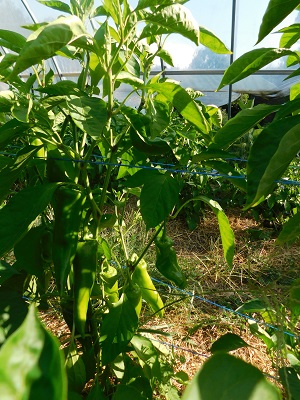High Tunnel Program
The Garrett Soil Conservation District has helped quite a number of farmers in Garrett County build high tunnels by administering grant funding for cost-share. High Tunnels allow for extending growing and the growing of crops that may be harder to grow in our area.
The high tunnel program is funded mainly through EQIP. Funds are extremely limited and competitive throughout the state. Therefore, local farmers need to be aware that generally there is a waiting list, and even if you qualify, funding may not happen for several years, or at all. But there is great news for this year.
EQIP has extra funding this year, and that means that we are going to be able to fund quite a few high tunnels for this and next year. But you need to apply. If you are serious about wanting a high tunnel, please contact Jacob Metcalf at 301-501-5862 or jacob.metcalf@usda.gov. Please be advised that tunnels that have a water source already available will be funded ahead of those requiring a spring or well development because there is a waiting list for design for water projects.
During years when funds are limited, applications are ranked according to the impact the tunnel will make on conservation and the community. Those receiving a first-time tunnel are ranked higher than those requesting a second tunnel. For a more detailed understanding of how EQIP works, please visit our EQIP Funding page. For this year, applications are not being ranked as strongly because of the large amount of funding resources. Therefore, those who already have a tunnel have a good chance of getting a second one right now. That is not always the case.
Who qualifies for a tunnel? Anyone can apply. You can be interested in a tunnel because you grow commercially or because you grow for your family and need to keep deer out of your garden. The only requirement is that you do plan to grow crops in your tunnel each year. You may have a small cost share. And you may have to pay for the tunnel up front and receive reimbursement after it is completed. The average cost runs about $16,000, though it may be less for smaller sized tunnels. Look for EQIP to pay from 80% to 100% depending upon your situation. If you have other needs in addition to the tunnel itself, such as running water from a distance or development of a water source, costs will be higher, and it may take significantly longer to receive your tunnel.
The only income limit to qualify is that you cannot make over $900,000 per year. You do not have to have animal units. And having a Nutrient Management plan is not a requirement for this particular pot of funding. (Which will be important to you if you are one of the Garrett County residents experiencing a delay in having a plan completed due to the loss of our county Nutrient Management specialist.)
Individuals receiving cost-share funding for a high tunnel will have to grow their crops in the ground inside of the tunnel, as opposed to in pots or containers. This is a requirement for the program.

So What's a High Tunnel?
High Tunnels are hoop houses that allow farmers to plant crops earlier and grow crops later in the season because they protect crops from the cold. They look similar to a green house, except crops are grown in the ground, as opposed to in pots, and there is no form of heat other than what is generated from the plastic that covers the tunnel holding in heat from the sun.
High tunnels allow farmers to better control water and nutrients than they can with field-grown plants. This reduces plant diseases.
Ways that high tunnels help the environment are that they:
- Extend the growing season
- Improve plant quality and soil quality
- Reduce nutrient and pesticide transportation
- Improve air quality through reduced transportation inputs
- Reduce energy use by providing consumers with a local source of fresh produce
High tunnels are constructed of steel pipes which are covered with greenhouse plastic. They range in size from very large to small, with most of the ones in our area being between 96′ and 24′ in length. The sides can generally be rolled up or down, depending upon the weather. Some farmers replace the plastic every year, but there are types of plastic that can last up to 3 years, so perspective high tunnel owners need to be aware that there are ongoing costs associated with owning a tunnel.
Farmers generally water plants through irrigation, so it may be necessary to run pipes underground from a water source. Often there is funding for this as well for those selected to be funded through the program.